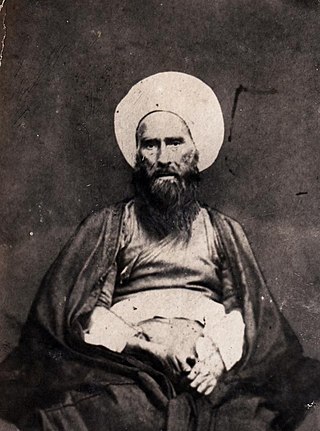Related Research Articles

"Shihāb ad-Dīn" Yahya ibn Habash Suhrawardī (1154–1191) was a philosopher and founder of the Iranian school of Illuminationism, an important school in Islamic philosophy. The "light" in his "Philosophy of Illumination" is the source of knowledge. He is referred to by the honorific title Shaikh al-ʿIshraq "Master of Illumination" and Shaikh al-Maqtul "the Murdered Master", in reference to his execution for heresy. Mulla Sadra, the Persian sage of the Safavid era described Suhrawardi as the "Reviver of the Traces of the Pahlavi (Iranian) Sages", and Suhrawardi, in his magnum opus "The Philosophy of Illumination", thought of himself as a reviver or resuscitator of the ancient tradition of Persian wisdom.

Ṣadr ad-Dīn Muḥammad Shīrāzī, more commonly known as Mullā Ṣadrā, was a Persian Twelver Shi'i Islamic mystic, philosopher, theologian, and ‘Ālim who led the Iranian cultural renaissance in the 17th century. According to Oliver Leaman, Mulla Sadra is arguably the single most important and influential philosopher in the Muslim world in the last four hundred years.
Transcendent theosophy or al-hikmat al-muta’āliyah, the doctrine and philosophy developed by Persian philosopher Mulla Sadra, is one of two main disciplines of Islamic philosophy that are currently live and active.

The Isfahan School is a school of Islamic philosophy. It was founded by Mir Damad and reached its fullest development in the work of Mulla Sadra. The name was coined by Seyyed Hossein Nasr and Henry Corbin.
Iranian philosophy or Persian philosophy can be traced back as far as to Old Iranian philosophical traditions and thoughts which originated in ancient Indo-Iranian roots and were considerably influenced by Zarathustra's teachings. According to the Oxford Dictionary of Philosophy, the chronology of the subject and science of philosophy starts with the Indo-Iranians, dating this event to 1500 BC. The Oxford dictionary also states, "Zarathustra's philosophy entered to influence Western tradition through Judaism, and therefore on Middle Platonism."

Hadi Sabzavari or Hajj Molla Hadi Sabzavari was an Iranian philosopher, mystic theologian and poet.

Bahāʾ al‐Dīn Muḥammad ibn Ḥusayn al‐ʿĀmilī, also known as Bahāddīn ʿĀmilī, or just Sheikh Bahāʾi, was a Levantine Arab Shia Islamic scholar, poet, philosopher, architect, mathematician and astronomer, who lived in the late 16th and early 17th centuries in Safavid Iran. He was born in Baalbek, Ottoman Syria but immigrated in his childhood to Safavid Iran with the rest of his family. He was one of the earliest astronomers in the Islamic world to suggest the possibility of the Earth's movement prior to the spread of the Copernican theory. He is considered one of the main co-founders of Isfahan School of Islamic Philosophy. In later years he became one of the teachers of Mulla Sadra.
Saʽid Qomi was an Iranian Shia philosopher of Qom's School.
Mul·lā "al-Muḥsin" "al-Fayḍ" al-Kāshānī was an Iranian Twelver Shi'i Muslim, mystic, poet, philosopher, and muhaddith.
Illuminationism, also known as Ishrāqiyyun or simply Ishrāqi is a philosophical and mystical school of thought introduced by Shahab al-Din Suhrawardi in the twelfth century, established with his Kitab Hikmat al-Ishraq, a fundamental text finished in 1186. Written with influence from Avicennism, Peripateticism, and Neoplatonism, the philosophy is nevertheless distinct as a novel and holistic addition to the history of Islamic philosophy.
ʿAbd-Al-Razzāq B. ʿAlī B. Al-Hosayn Lāhījī was an Iranian theologian, poet and philosopher. His mentor in philosophy was his father-in-law Mulla Sadra.
Kasr al-asnam al-jahiliyyah fi dhamm al-mutasawwifin. The word "mutasawwifin" referred to here is not used according to its usual meaning of one who follows Sufism but means one who pretends to follow it. In this treatise, Mulla Sadra criticizes the excesses of those in his day who, pretending to be Sufis, disregarded the Shari'ah and its teachings.
Molla Naima Taleghani, also known as Orfi, was an Iranian Shia philosopher and theologian of the late Safavid era.
Seddiqin Argument or the argument of the righteous is an argument for the existence of God in Islamic philosophy. This argument was explained by Islamic philosophers such as Avicenna, Mulla Sadra and Muhammad Husayn Tabataba'i.
Mulla Hamzah Gilani was an Iranian shia philosopher. He was one of the pupils of Muhammad Sadiq Ardestani.
Molla Abdul Rahim Damavandi (1737-1757) was an Iranian shia philosopher and one of the leading of Zahabiyyah Tarighah.
The Transcendent Philosophy of the Four Journeys of the Intellect, known as Four Journeys, is an extended compendium of Islamic philosophy written by the 17th century Islamic scholar, Mulla Sadra, In which he attempted to reach Sufism and prove the idea of Unity of Existence by offering a new intake and perspective on Peripatetic philosophy that was offered by Alpharabius and Avicenna in the Islamic world. The book explains his philosophy of transcendent theosophy. It was first published in print in 1865 in Tehran in four volumes, where it was accompanied by a commentary on three of the volumes by Hadi Sabzavari (1797–1893). To date, no notable, critical English translation of the book has been made.
Tafasir Al Quran are collections of books as commentaries on the Quran, written by Mulla Sadra.
Muhammad Mahdi Naraqi (1795–1715) was a Twelver Shi'i scholar, theologian and moral philosopher. Al-Naraqi was a brilliant thinker of the late 12th/18th and early 13th/l8th century. His son, Molla Ahmad Naraqi, was also a celebrated Twelver scholar. In the Qajar dynasty, he was prominent scholar at the philosophy and continued philosophical activities in the Kashan, Iran.
References
- ↑ ( Saayed Jalaloddin Ashtiyani & vol.4 1978 , p. 2)
- ↑ ( Corbin 1993 , p. 348)
- ↑ ( Corbin 1993 , p. 349)
- ↑ ( Corbin 1993 , p. 349)
- ↑ ( Corbin 1993 , p. 349)